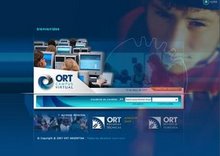 From its beginning, the Web 2.0 – especially blogs and wikis- was characterized as the “Social Web”. As Michael Wesch said: “the Web 2.0 is connecting people”. A year ago, we mentioned the main discussions that were being carried out at ORT’s web of blogs, both inside and outside the school, with other people and communities (courtesy of the Web).
From its beginning, the Web 2.0 – especially blogs and wikis- was characterized as the “Social Web”. As Michael Wesch said: “the Web 2.0 is connecting people”. A year ago, we mentioned the main discussions that were being carried out at ORT’s web of blogs, both inside and outside the school, with other people and communities (courtesy of the Web).Last year, social networks settled in our society in a remarkable way. We have incorporated, as part of our everyday vocabulary, terms such as links, profiles, groups and messages, either at LinkedIn, Sonico, Facebook, or MySpace.
There is a new service available at the Virtual Campus -service which maybe shows more clearly the innovative spirit of ORT: “Friends” is a horizontal and open space, thought to continue building these bonds among the different members of the educational community (though in the future the idea is to articulate it with other social networks from outside). Its first inhabitants, who seem to have come to stay, are our students.
Evidently, innumerable questions related to the implementation of ‘Friends’ arise. Can the real communities of practice that constitute the projects develop at this new space of “social networks”? Is it possible to generate new strategies to intervene through these new ways of emerging social organization? Can this communication space become a learning environment? Can this work as ‘support’ for team work, which is so common in our schools?
As in the classroom, there is a public space here and the possibility to get together according to interests or issues in common. In our everyday life, we will have to rethink of what is ephemeral and long-lasting, what is public or private, of curricular and non-curricular issues, which are also at stake here.
It is said that one of the biggest challenges that blogs and the new spaces for content production in the Web have to face is the creation of communities around contents. Within this framework, the “aggregation” (that essential practice of “social networks”) gets fundamental importance. We invite you to continue experimenting, to share findings, but above all, to keep on being pioneers.
To use “Friends”, you need to log in at the Campus with a user’s name and a personal password. Once at the Campus, next to the editing permissions, there is an orange icon from which you can have access.









